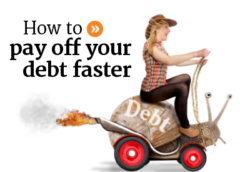
Strategies to Pay Off Debt Faster: Achieve Financial Freedom Sooner
Paying off debt faster can help you save money on interest, reduce financial stress, and achieve your financial goals sooner. Here are some strategies to help you pay off your debt more quickly:
1. Create a Debt Repayment Plan
List All Debts: Write down all your debts, including balances, interest rates, and minimum monthly payments. Knowing the full scope of your debt is the first step toward paying it off.
Choose a Strategy: Decide between the debt snowball method (paying off the smallest debts first) or the debt avalanche method (paying off the highest interest rate debts first). The debt snowball method provides quick wins and can boost motivation, while the debt avalanche method saves money on interest over time.
2. Increase Your Monthly Payments
Pay More Than the Minimum: Aim to pay more than the minimum payment on your debts to reduce the principal faster. Even small additional payments can make a significant difference over time.
Make Biweekly Payments: Split your monthly payment in half and pay every two weeks, effectively making an extra payment each year. This can reduce your balance more quickly and save on interest.
3. Reduce Your Interest Rates
Negotiate Lower Rates: Contact your creditors to negotiate lower interest rates. A lower rate can make your payments more effective at reducing your principal balance.
Refinance or Consolidate: Consider refinancing high-interest loans or consolidating multiple debts into a single loan with a lower interest rate. This can simplify your payments and save on interest.
4. Cut Expenses and Reallocate Funds
Trim Your Budge : Identify areas where you can cut back and reallocate those savings towards debt repayment. Reducing discretionary spending on items like dining out or entertainment can free up additional funds.
Use Windfalls Wisely: Apply any bonuses, tax refunds, or unexpected income towards your debt. These extra funds can provide a significant boost to your repayment efforts.
5. Increase Your Income
Side Hustles: Take on freelance work, part-time jobs, or gig economy opportunities to earn extra income. Additional income can be directed entirely toward debt repayment.
Sell Unused Items: Sell items you no longer need on platforms like eBay, Craigslist, or Facebook Marketplace. This can provide extra cash to pay down your debt.
6. Automate Payments
Set Up Automatic Payments: Automate your debt payments to ensure consistency and avoid late fees. This can help you stay on track and avoid missed payments.
Prioritize Debt Repayment: Treat debt repayment as a fixed expense in your budget. This ensures that it remains a priority each month.
7. Use Balance Transfers Wisely
Zero-Interest Balance Transfers: Transfer high-interest credit card balances to a card with a 0% introductory APR, but be sure to pay off the balance before the promotional period ends. This can provide temporary relief from interest charges and accelerate your repayment.
8. Avoid Accumulating New Debt
Limit Credit Card Use: Use cash or debit cards for purchases to avoid adding to your debt. This helps prevent the cycle of accruing more debt while trying to pay off existing balances.
Avoid Financing New Purchases: Delay major purchases until you can afford to pay for them in full. This prevents new debt from interfering with your repayment progress.
9. Stay Motivated and Monitor Progress
Set Milestones: Break your debt repayment goals into smaller, manageable milestones and celebrate your progress. Recognizing small victories can keep you motivated.
Track Your Progress: Regularly review your debt balances and see how much progress you’ve made. This helps maintain focus and commitment to your repayment plan.
Example Plan
Assume you have three debts:
1. Credit Card A: $3,000 balance, 18% interest rate, $90 minimum payment.
2. Credit Card B: $5,000 balance, 15% interest rate, $150 minimum payment.
3. Personal Loan: $7,000 balance, 10% interest rate, $200 minimum payment.
Debt Avalanche Method:
1. Pay the minimum on Credit Card B and the Personal Loan.
2. Allocate extra funds to Credit Card A (highest interest rate) until it’s paid off.
3. Once Credit Card A is paid off, focus on Credit Card B (next highest interest rate).
4. Finally, pay off the Personal Loan.
Debt Snowball Method:
1. Pay the minimum on Credit Card B and the Personal Loan.
2. Allocate extra funds to Credit Card A (smallest balance) until it’s paid off.
3. Once Credit Card A is paid off, focus on Credit Card B (next smallest balance).
4. Finally, pay off the Personal Loan.
Additional Tips
Debt Counseling: Seek advice from a credit counselor if you need help managing your debt. They can provide personalized strategies and support.
Debt Repayment Apps: Use apps like Undebt.it or Tally to help you manage and accelerate your debt repayment. These tools can offer tracking and reminders to keep you on course.
By following these strategies and staying disciplined, you can pay off your debt faster and work towards financial freedom. The key is to be consistent, stay motivated, and make smart financial decisions.




